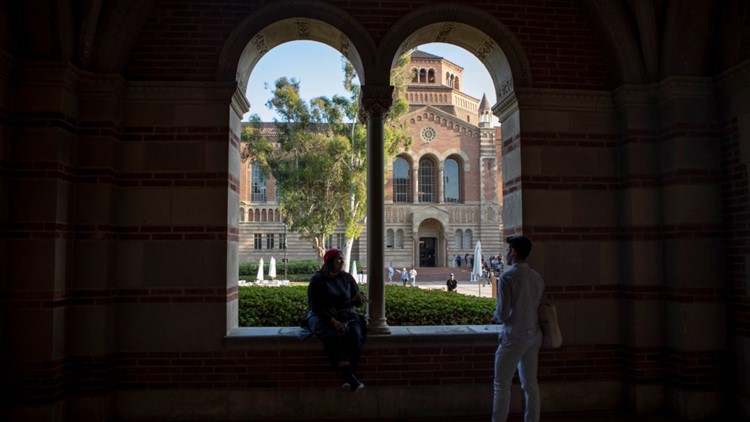CALIFORNIA, USA — This story was originally published by CalMatters.
Sami Siegelbaum loved teaching art history at UCLA even when his office space was a storage closet.
The pay, at around $27,000 a year for the part-time job, wasn't great, though it was more than what he made at his teaching posts at two other colleges.
But after four years, his UCLA teaching contract wasn’t renewed in 2019 with little explanation. The university wanted to “bring in new approaches” about every three years, his department chair wrote to him, noting that the decision had nothing to do with any evaluation. In fact, Siegelbaum said no one from the department ever observed his teaching.
Each year, Siegelbaum is one of thousands of University of California lecturers whose teaching contracts aren’t renewed, underscoring the paltry job security available to a vital segment that provides one-third of the instruction undergraduate students receive at the vaunted four-year public university system.
About a quarter or more of lecturers working one year disappeared from UC employment rolls the following year annually between 2015 and 2020, according to a CalMatters analysis of UC personnel data that it acquired from the university through a public records request. The findings largely mirror the lecturer union’s internal data it shared with CalMatters.
That’s a much higher rate than for other state and local education workers. Nationally, just less than a fifth separated from their jobs annually, according to federal labor statistics. But the nation’s labor force is a more volatile place overall: Among all nonfarm workers, about 42% to 45% separated from their jobs in each of the years between 2015 and 2019.
The lecturer turnover — also known as churn — in that time at the UC has been an average of about about 1,440 lecturers annually and peaked at 1,618 in 2020. But paradoxically, the overall number of UC lecturers continues to grow, raising speculation among the union representing lecturers that the UC is relying on a cadre of part-time workers with few protections to educate its more than 285,000 students and keep costs low. The figures don't say why lecturers leave, though the lecturers' union maintains that most aren't re-appointed by the UC rather than leave on their own volition.
The UC refers to the churn as “alleged” in a document posted on the system’s website in March. It counters that not all lecturers want to teach regularly, citing examples of professionals such as dentists and lawyers who have full-time jobs and also lecturers who seek other employment after a couple years. It also cites budgetary changes at departments and that courses lecturers teach aren’t always recurring.
The UC declined to make anyone available to interview for this story despite multiple requests over several months.
The lecturers have had it. Over the summer the union’s members voted to allow union leadership to declare a strike. That gives the union some leverage in its negotiations with the UC president's office in crafting a new contract. Helping the union’s efforts is support from tenured and tenure-track faculty who hold more sway in university affairs. By early October more than 400 tenured faculty had signed a petition saying they would cancel their classes in solidarity with the lecturer union if it strikes.
All told, the anger of the lecturers could lead to thousands of canceled classes affecting more than a third of undergraduates.
Lecturers occupy a tenuous position in the instructional hierarchy at the UC. Unlike tenured and tenure-track faculty, lecturers rarely have assurances of continuous employment.
Current UC labor rules give lecturers more job stability if they work in the same department for 12 semesters or 18 quarters — the equivalent of six years — and pass an “excellence” review. Reaching that level of job security, however, can take even longer if lecturers aren’t assigned teaching positions every term or change departments. Before reaching that continuing status, lecturers can be let go for any or no reason, and generally don’t have any expectation of keeping their positions year to year. Once they get that continuing status, lecturers can still be laid off, but only with a year’s notice, buying them more time to find work elsewhere.
Lecturers are also guaranteed a 6% raise, often their first, after three cumulative years in the same department. But the average time of employment for UC lecturers is just two years, meaning many won’t qualify for that wage bump.
Said Mia McIver, a lecturer and president of UC-AFT, the union representing the UC’s more than 6,000 lecturers: “What we're fighting for is to stop the gig-ification of the university.”
To her, the combination of lecturer turnover and prevalence of part-time work spells out a situation in which “the UC often expects us to take the pride and prestige of teaching at the University of California as part of our compensation package, which it is not.”
A spokesperson for the UC Office of the President wrote that the “UC highly values its lecturers” and this “is reflected in the fact that UC lecturers enjoy some of the best pay, benefits and working conditions in the country.”
Lecturers push back on that characterization, with many pointing out that the UC is unique in California for offering no review process for lecturers, which allows campuses to dismiss the instructors without explaining why — arguably the biggest sticking point for UC lecturers.
As the state’s third-largest employer, UC has an outsized labor role in California. For unions and workers’ rights advocates, the system can set the tone for labor issues both statewide and nationally.
Labor contract impasse
The union has been operating without a new contract since February 2020. Negotiations with the UC president’s office are at an impasse after two years of failed efforts. Right now the minimum pay for full-time lecturers is $57,000. According to federal housing data, that's a low-income wage in areas where six of the nine UC undergraduate campuses are located. The UC is proposing certain pay bumps for lecturers; the union argues those raises won’t keep pace with inflation.
Lecturers have long complained that the UC relies on their temporary status as a cost-cutting tactic. It’s partly why lecturers went on strike in 2002. The result of that work stoppage was the “continuing lecturer” status that gave some lecturers an indefinite teaching appointment.
The UC has increasingly relied on their work to teach classes. Since 2011, the number of lecturers at the UC has risen by 41% while faculty on the permanent track have risen just 19%.
The UC maintains that it provides generous job stability to lecturers, saying that it’s one one of two universities in the U.S. where lecturers can continue their appointment indefinitely once they clear that six-year threshold to receive continuing appointments.
But union data suggests there’s scant hope of continuous employment: About 1,200 of the more than 6,300 lecturers in 2019-20 had continuing status (the data CalMatters obtained through a public records request doesn’t contain continuing lecturer status).
National comparisons for lecturer churn are virtually non-existent. When CalMatters shared the UC churn data findings with Adrianna Kezar, a leading scholar on faculty labor dynamics at the University of Southern California, she said the numbers are evidence of a lecturer turnover crisis that isn’t getting enough attention.
“I think you're articulating something that people aren't even recognizing as a crisis, which I think is important,” Kezar said. “I don't hear people talking enough about the churn issue.”
Preserving more lecturers has equity implications, too. Lecturers are more likely to be women and people of color. While 65% of tenured faculty were white, the same was true for just 57% of lecturers in 2020. Two-thirds of tenured faculty were men in 2019; more than half of lecturers were women. Pervasive part-time appointments for lecturers often mean moonlighting shifts at other colleges or gig work. UC’s lecturers each earn $32,000 per year, according to a CalMatters analysis of UC wage data through a public records request, in part because so many are given part-time assignments.
For students, the revolving door of lecturers upends valuable relations they’ve developed with educators who’ve inspired or mentored them in one year only to be gone completely the next.
Decades of research show that the more students interact with faculty, the more they gain from their college educations.
“It's incredibly problematic if the faculty are not there to develop these relationships,” said Kezar, the USC professor, in an interview. She co-wrote a paper on the effect faculty churn can have on student academics.
Possible strike
The two sides are now in state-led mediation through the California Public Employment Relations Board. If mediation doesn’t lead to both parties agreeing on a contract, state law allows either side to call for the creation of a fact-finding panel that can issue non-binding solutions. The UC Board of Regents, which oversees the UC system, then may have to vote publicly on whether to adopt those recommendations.
If it comes down to a decision by the Regents, expect fireworks. Several tenured faculty called during the July and September meetings to voice their solidarity with the union even though their jobs are secure.



